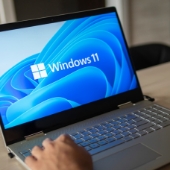Posted on Wednesday April 05, 2023
 One of the most common ways cybercriminals gain access to business networks is through unsecured web browsers. Cybercriminals can exploit vulnerabilities in these browsers to launch an attack on your systems. To ensure the safety of your business, use one of these secure browsers.
One of the most common ways cybercriminals gain access to business networks is through unsecured web browsers. Cybercriminals can exploit vulnerabilities in these browsers to launch an attack on your systems. To ensure the safety of your business, use one of these secure browsers.

Posted on Monday April 03, 2023
 Adopting new technology is essential in business today. Failure to do so may result in missed opportunities to leverage tools that can enhance the efficiency of your work and strengthen your business. Here are several business benefits of adopting new technology.
Adopting new technology is essential in business today. Failure to do so may result in missed opportunities to leverage tools that can enhance the efficiency of your work and strengthen your business. Here are several business benefits of adopting new technology.

Posted on Friday March 31, 2023
 Microsoft released Windows 11 in October 2021. As of October 2022, only 15.44% of PCs around the world run the new operating system (OS); 71.29% are still using Windows 10. One possible reason for the slow adoption of the new OS is that Windows 11 would not install on devices that lack Trusted Platform Module (TPM) 2.0 chips.
Microsoft released Windows 11 in October 2021. As of October 2022, only 15.44% of PCs around the world run the new operating system (OS); 71.29% are still using Windows 10. One possible reason for the slow adoption of the new OS is that Windows 11 would not install on devices that lack Trusted Platform Module (TPM) 2.0 chips.

Posted on Wednesday March 29, 2023
 Despite improvements in cybersecurity solutions in recent years, a significant proportion of small businesses still rely on basic levels of protection. This approach is no longer viable, as cybercriminals have become highly adept at social engineering techniques and at identifying vulnerabilities in software and processes that they can take advantage of. In this blog, we’ll provide you with rapid and effective means of improving your cybersecurity posture to protect your business against ever-evolving cyberthreats.
Despite improvements in cybersecurity solutions in recent years, a significant proportion of small businesses still rely on basic levels of protection. This approach is no longer viable, as cybercriminals have become highly adept at social engineering techniques and at identifying vulnerabilities in software and processes that they can take advantage of. In this blog, we’ll provide you with rapid and effective means of improving your cybersecurity posture to protect your business against ever-evolving cyberthreats.

Posted on Monday March 27, 2023
 If you've just bought a new Android device, there's a good chance that it came pre-installed with some apps that you don't want or need. Find out how to clear the clutter from your Android device and get rid of those unwanted apps.
If you've just bought a new Android device, there's a good chance that it came pre-installed with some apps that you don't want or need. Find out how to clear the clutter from your Android device and get rid of those unwanted apps.

Posted on Friday March 24, 2023
 If you're a Mac user, you probably already know that macOS boasts a remarkable built-in feature called Time Machine, which helps easily recover deleted files, emails, or media. If you're not using it, it's about time that you do. This reliable backup mechanism maintains an accurate, up-to-date record of your Mac's contents. Keep reading to learn how to maximize the benefits of Time Machine.
If you're a Mac user, you probably already know that macOS boasts a remarkable built-in feature called Time Machine, which helps easily recover deleted files, emails, or media. If you're not using it, it's about time that you do. This reliable backup mechanism maintains an accurate, up-to-date record of your Mac's contents. Keep reading to learn how to maximize the benefits of Time Machine.
